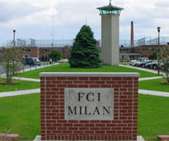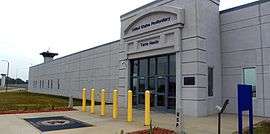Federal Bureau of Prisons
The Federal Bureau of Prisons (BOP) is a United States federal law enforcement agency under the Department of Justice responsible for the care, custody, and control of incarcerated individuals.
 Seal of the Federal Bureau of Prisons | |
| Agency overview | |
|---|---|
| Formed | 1930 |
| Headquarters | Federal Home Loan Bank Board Building Washington, D.C., U.S. |
| Motto | Correctional Excellence. Respect. Integrity. |
| Employees | 36,697[1] |
| Annual budget | 7.3 billion USD (FY 2016)[2] |
| Agency executives |
|
| Parent agency | Department of Justice |
| Website | www |

History
The federal prison system had existed for more than 30 years before the Bureau was established. Although its wardens functioned almost autonomously, the Superintendent of Prisons, a Department of Justice official in Washington, was nominally in charge of federal prisons,[3] starting with the passage of the "Three Prisons Act' in 1891, which authorized the first three federal penitentiaries: USP Leavenworth, USP Atlanta, and USP McNeil Island with limited supervision by the Department of Justice.[4]
Until 1907, prison matters were handled by the Justice Department General Agent, with responsibility for Justice Department accounts, oversight of internal operations, and certain criminal investigations, as well as prison operations. In 1907, the General Agent was abolished, and its functions were distributed between three new offices: the Division of Accounts (which evolved into the Justice Management Division); the Office of the Chief Examiner (which evolved in 1908 into the Bureau of Investigation, and in the early 1920s into the Federal Bureau of Investigation); and the Office of the Superintendent of Prisons and Prisoners, later called the Superintendent of Prisons (which evolved in 1930 into the Bureau of Prisons).

The Bureau of Prisons was established within the Department of Justice in 1930, by the United States Congress,[5] and was charged with the "management and regulation of all Federal penal and correctional institutions."[6] This responsibility covered the administration of the 11 federal prisons in operation at the time. By the end of 1930, the system had expanded to 14 institutions with 13,000 inmates, and a decade later in 1940, the system had 24 institutions with 24,360 incarcerated.
The state of Alaska assumed jurisdiction over its corrections on January 3, 1959, using the Alaska Department of Corrections. Prior to statehood, the BOP had correctional jurisdiction over Alaska.[7]
As a result of the Sentencing Reform Act of 1984 and subsequent legislation which pushed for longer sentences, less judicial discretion, and more harsh sentences for drug-related offenses, the federal inmate population doubled in the 1980s and again in the 1990s. The population increase has decelerated since the early 2000s but the federal inmate population continues to grow.[8]
The National Capital Revitalization and Self-Government Improvement Act of 1997 transferred responsibility for adult felons convicted of violating District of Columbia laws to the Bureau.
Administration and employees
The current director of the Bureau of Prisons is Michael Carvajal.[9][10]
As of 2020, 62.5% of Bureau employees are white, 21.3% are black, 12.6% are Hispanic, 2.3% are Asian and 1.3% are Native American. 72% are male.[11] There is roughly one corrections officer for every 10 prisoners.[12]
All Bureau employees undergo 200 hours of formal training in their first year of employment and an additional 120 hours of training at the Federal Law Enforcement Training Centers (FLETC) in Glynco, Georgia.[13]
Types of federal prisons

The Bureau has five security levels:
- Federal Prison Camps (FPCs), the BOP minimum-security facilities, feature a lack of or a limited amount of perimeter fencing, and a relatively low staff-to-inmate ratio.
- Low-security Federal Correctional Institutions (FCIs) have double-fenced perimeters, and inmates live in mostly cubicle or dormitory housing.
- Medium-security FCIs and some United States Penitentiaries (USPs) are classified to hold medium-security inmates. The medium facilities have strengthened perimeters, which often consist of double fences with electronic detection systems. Medium-security facilities mostly have cell housing.
- Most U.S. Penitentiaries are classified as high-security facilities. The perimeters, highly secured, often have reinforced fences or walls.
- Federal Correctional Complexes (FCCs) are co-locations of BOP facilities with different security levels and/or genders.[14]
- Administrative Security Facilities are prisons with special missions and capabilities. An example would be Federal Medical Centers which house sick and injured inmates getting medical care which is beyond the capabilities of a normal institution.
Some units have small, adjacent, minimum-security "satellite camps". Twenty-eight institutions hold female inmates. As of 2010 about 15% of Bureau inmates are in facilities operated by third parties, mostly private companies, whilst others are in local and state facilities. Some are in privately operated Residential Reentry Centers (RRC) (or Community Corrections Centers). The Bureau uses contract facilities to manage its own prison population because they are "especially useful" for housing low-security, specialized groups of people, such as sentenced criminal aliens.[15]
Inmate population
| FY | Population | Change |
|---|---|---|
| 2000 | 145,125 | +11,436 |
| 2001 | 156,572 | +11,447 |
| 2002 | 163,436 | +6,864 |
| 2003 | 172,499 | +9,063 |
| 2004 | 179,895 | +7,396 |
| 2005 | 187,394 | +7,499 |
| 2006 | 192,584 | +5,190 |
| 2007 | 200,020 | +7,436 |
| 2008 | 201,668 | +1,648 |
| 2009 | 208,759 | +7,091 |
| 2010 | 210,227 | +1,468 |
| 2011 | 217,768 | +7,541 |
| 2012 | 218,687 | +919 |
| 2013 | 219,298 | +611 |
| 2014 | 214,149 | -5,149 |
| 2015 | 205,723 | -8,426 |
| 2016 | 192,170 | -13,553 |
| 2017 | 185,617 | -6,553 |
| 2018 | 181,698 | -3,919 |
| 2019 | 177,214 | -4,484 |
As of 2020, the Bureau was responsible for approximately 170,400 inmates,[16] in 122 facilities.[17] 58.2% of inmates were white, 38% were black, 2.3% native American, and 1.5% Asian; 93% were male.[18] 75% of inmates were between the ages of 26 and 50.[19]
As of 1999, 14,000 prisoners were in 16 federal prisons in the state of Texas.[20]
As of 2010, almost 8,000 felons in 90 facilities, sentenced under D.C. laws, made up about 6% of the total Bureau population.[21]
As of October 2016, 46% of inmates were incarcerated for drug offences.[22]
The BOP receives all prisoner transfer treaty inmates sent from foreign countries, even if their crimes would have been, if committed in the United States, tried in state, DC, or territorial courts.[23]
Female inmates
As of 2015, 27 Bureau facilities house women. The Bureau has a Mothers and Infants Nurturing Together (MINT) program for women who enter the system as inmates while pregnant. The Bureau pays for abortion only if it is life-threatening for the woman, but it may allow for abortions in non-life-threatening cases if non-BOP funds are used.[24]
In 2017, four Democratic Senators, including Kamala Harris, introduced a bill explicitly requiring tampons and pads to be free for female prisoners. In August 2017, the Bureau introduced a memorandum requiring free tampons and pads. The previous 1996 memorandum stated "products for female hygiene needs shall be available" without requiring them to be free of charge.[25]
A 2018 review by the Evaluation and Inspections Division, Office of the Inspector General, U.S. Department of Justice, found the Bureau's programming and policy decisions did not fully consider the needs of female inmates in the areas of trauma treatment programming, pregnancy programming, and feminine hygiene.[26]
Juvenile inmates
As of 2010 typically juveniles sent into Bureau custody are between 17 and 20, must have been under 18 at the time of the offense and had been convicted of sex-related offenses. This is because the most severe crimes committed on Indian Reservations are usually taken to federal court. According to the Bureau, most of the juveniles it receives had committed violent crimes and had "an unfavorable history of responding to interventions and preventive measures in the community." As of that year most federal juvenile inmates were from Arizona, Montana, South Dakota, Nebraska, and the District of Columbia (in no particular order).[27]
The Bureau contracts with facilities that house juvenile offenders. Title 18 U.S.C. 5039 specifies that "No juvenile committed...may be placed or retained in an adult jail or correctional institution in which he has regular contact with adults incarcerated because they have been convicted of a crime or are awaiting trial on criminal charges." The definition includes secure facilities and community-based correctional facilities. Federally sentenced juveniles may be moved into federal adult facilities at certain points; juveniles sentenced as adults are moved into adult facilities when they turn 18. Juveniles sentenced as juveniles are moved into adult facilities when they turn 21.[28]
Death row inmates

The Comprehensive Crime Control Act of 1984 reinstituted the federal death penalty.[29] On July 19, 1993, the federal government designated the United States Penitentiary, Terre Haute in Indiana as the site where male federal inmates sentenced to death would be held and where federal inmates of both genders would be executed. The Federal Medical Center, Carswell in Texas holds the female inmates who have been sentenced to death.
Some male death row inmates are instead held at ADX Florence,[30] and one in USMCFP Springfield.
As of July 2020, 60 inmates are slated for death row.[31]
Overpopulation and responses
Parole was abolished for federal inmates in 1987 and inmates must serve at least 85% of their original sentence before being considered for good-behavior release. In addition, the current, extremely strict, sentencing guidelines were adopted in response to rising crime rates in the 1980s and early 1990s, especially for drug-related offenses.[32][33] US violent crime has dropped since then, but some analysts and activists believe that other factors played a much more significant part in falling crime rates. In addition, they hold that strict federal sentencing guidelines have led to overcrowding and needlessly incarcerated thousands of non-violent drug offenders who would be better served by drug treatment programs.[34]
The yearly increases in the federal inmate population have raised concerns from criminal justice experts and even among DOJ officials themselves. Michael Horowitz, the DOJ Inspector General, wrote a memorandum concerning this issue:
First, despite a slight decrease in the total number of federal inmates in fiscal year (FY) 2014, the Department projects that the costs of the federal prison system will continue to increase in the years ahead, consuming a large share of the Department’s budget. Second, federal prisons remain significantly overcrowded and therefore face a number of important safety and security issues.[35]
Coronavirus disease 2019 (COVID-19)
As of July 30, 2020, there are 2,910 federal inmates and 500 BOP staff who have confirmed positive test results for Coronavirus disease 2019 COVID-19 nationwide. 7312 inmates and 683 staff have recovered. There have been 99 federal inmate deaths and 1 BOP staff member deaths attributed to COVID-19 disease.[36]
See also
- Federal crime in the United States
- List of U.S. federal prisons
- Incarceration in the United States
- List of United States federal law enforcement agencies
- National Institute of Corrections
- Federal Prison Industries, Inc. (UNICOR)
References
- Arons, Anna, Katherine Culver, Emma Kaufman, Jennifer Yun, Hope Metcalf, Megan Quattlebaum, and Judith Resnik. "Dislocation and Relocation: Women in the Federal Prison System and Repurposing FCI Danbury for Men." Yale Law School, Arthur Liman Public Interest Program. September 2014.
Notes
- "BOP:About Our Agency". bop.gov. Federal Bureau of Prisons. May 2, 2020. Archived from the original on April 30, 2020. Retrieved May 2, 2020.
36,697 Employees
- "FY 2016 Budget Summary" (PDF). U.S. Justice Department.
- John W. Roberts (1997). "The Federal Bureau of Prisons: Its Mission, Its History, and Its Partnership with Probation and Pretrial Services". Federal Probation. 61: 53. ISSN 0014-9128. OCLC 2062391.
- Bosworth, Mary (2002). The U.S. Federal Prison System. SAGE. p. 4. ISBN 978-0761923046.
- Pub.L. 71–218, 46 Stat. 325, enacted May 14, 1930
- "Statutory Authority to Contract With the Private Sector for Secure Facilities". US Department of Justice. Archived from the original on February 9, 2010. Retrieved November 17, 2013.
- "History of Lemon Creek Correctional Center" (Archive). Alaska Department of Corrections. Retrieved on December 13, 2015.
- Delgado, Marlo (July 2016). "Federal Bureau of Prisons". JailData.com. Retrieved September 13, 2016.
- "BOP: New Director Appointed". www.bop.gov.
- "BOP:Michael Carvajal, Director". bop.gov. Federal Bureau of Prisons. May 1, 2020. Archived from the original on April 6, 2020. Retrieved May 1, 2020.
Mr. Carvajal became the Assistant Director for the Correctional Programs Division on August 19, 2018 and held that position until the Attorney General appointed him as the Bureau's 11th Director on February 25, 2020.
- "Staff Statistics". Federal Bureau of Prisons. US Department of Justice. May 2, 2020. Archived from the original on January 23, 2020. Retrieved May 2, 2020.
- Reilly, Steve (May 6, 2018). "Prison violence rises as budgets slashed". USA Today. pp. 1A, 2A. Retrieved August 13, 2018.
- "World-class correctional instruction". Federal Bureau of Prisons: About Our Facilities. US Department of Justice. Archived from the original on April 12, 2020. Retrieved November 2, 2015.
- "Prison Types & General Information Archived September 15, 2012, at the Wayback Machine." Federal Bureau of Prisons. Retrieved May 21, 2010.
- "CI Rivers Contact Information." Federal Bureau of Prisons. Retrieved January 12, 2010.
- "Population Statistics". Federal Bureau of Prisons. Archived from the original on April 28, 2020. Retrieved May 2, 2020.
- "BOP: Our Locations". www.bop.gov. Archived from the original on April 28, 2020. Retrieved May 2, 2020.
- "Federal Bureau of Prisons: Inmates Statistics". Federal Bureau of Prisons. US Department of Justice. April 16, 2018. Retrieved April 16, 2018.
- "BOP Statistics: Average Inmate Age". www.bop.gov. Retrieved April 16, 2018.
- Tedford, Deborah. "Opening of U.S. detention center delivers some much-needed space." Houston Chronicle. October 16, 1999. p. A35 MetFront. NewsBank Record: 3171576. Available from the Houston Public Library. "Sixteen of the nation's 94 federal prisons are in Texas and house 14,000 convicts, Marler said."
- Fornaci, Philip (Director of the DC Prisoners' Project). "Federal Bureau of Prisons Oversight Hearing" (Archive). Subcommittee on Crime, Terrorism, and Homeland Security. U.S. House of Representatives Committee on the Judiciary. July 21, 2009. Retrieved on February 5, 2016.
- "BOP Statistics: Inmate Offenses". www.bop.gov. Retrieved December 10, 2016.
- "Transfer Of State Prisoners." United States Department of Justice. Retrieved on April 14, 2016.
- "Female offenders." Federal Bureau of Prisons. Retrieved on December 13, 2015.
- Tolan, Casey (August 11, 2017). "Bureau of Prisons requires free tampons for female inmates, following Harris bill". Mercury News. Retrieved August 12, 2017.
- Review of the Federal Bureau of Prisons' Management of Its Female Inmate Population. Washington, DC: Office of the Inspector General, U.S. Department of Justice, Evaluation and Inspections Division. September 2018. Retrieved September 22, 2018.
- "Juveniles in the Bureau". Federal Bureau of Prisons. Retrieved on January 1, 2010.
- "Community Corrections FAQs Archived December 2, 2010, at the Wayback Machine." Federal Bureau of Prisons. Retrieved September 14, 2010.
- "The Bureau Celebrates 80th Anniversary Archived May 28, 2010, at the Wayback Machine ." Federal Bureau of Prisons. May 14, 2010. Retrieved on October 3, 2010.
- Sargent, Hillary; Dwyer, Dialynn (July 17, 2015). "Tsarnaev moved to supermax prison. Here's how he'll live". Boston Globe. Archived from the original on December 13, 2015. Retrieved December 13, 2015.
- "BOP Statistics: Sentences Imposed". www.bop.gov. Retrieved April 16, 2018.
- "Federal Bureau of Prisons – Statistics". Federal Bureau of Prisons. US Department of Justice. November 2, 2015. Retrieved November 2, 2015.
- La Vigne, Nancy; Samuels, Julie (December 12, 2012). "The Growth & Increasing Cost of the Federal Prison System: Drivers and Potential Solutions" (PDF). urban.org. Retrieved November 2, 2015.
- Schwartzapfel, Beth (July 23, 2015). "Federal Prisons Could Release 1,000 Times More Drug Offenders Than Obama Did". The Marshall Project. Retrieved November 2, 2015.
- Cohen, Andrew (November 17, 2014). "Obama's Prison Crisis". The Marshall Project. Retrieved November 2, 2015.
- "BOP: COVID-19 Update". bop.gov. Federal Bureau of Prisons. May 1, 2020. Archived from the original on April 29, 2020. Retrieved May 2, 2020.
The BOP has 128,696 federal inmates in BOP-managed institutions and 13,757 in community-based facilities. The BOP staff complement is approximately 36,000. As of 07/30/2020, there are 2910 federal inmates and 500 BOP staff who have confirmed positive test results for COVID-19 nationwide. Currently, 7312 inmates and 683 staff have recovered. There have been 99 federal inmate deaths and 1 BOP staff member deaths attributed to COVID-19 disease.
Further reading
External links
| Wikimedia Commons has media related to Federal Bureau of Prisons. |
